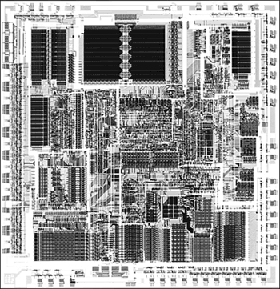Second-Generation Processors
The second generation of PC processors allowed for a great leap in system speed and processing efficiency. With these chips we went from moving 8 bits of data around to moving 16 bits at a time. The following section details the second-generation PC processor, the 286.
286 Processors
The Intel 80286 (normally abbreviated as 286) processor did not suffer from the compatibility problems that damned the 80186 and 80188. The 286 chip, first introduced in 1981, is the CPU behind the original IBM PC AT (Advanced Technology). Other computer makers manufactured what came to be known as IBM clones, with many of these manufacturers calling their systems AT-compatible or AT-class computers.
When IBM developed the AT, it selected the 286 as the basis for the new system because the chip provided compatibility with the 8088 used in the PC and the XT. Therefore, software written for those chips should run on the 286.
The 286 chip is many times faster than the 8088 used in the XT, and at the time it offered a major performance boost to PCs used in businesses. The processing speed, or throughput, of the original AT (which ran at 6MHz) is five times greater than that of the PC running at 4.77MHz. The die for the 286 is shown in Figure below.

286 systems are faster than their predecessors for several reasons. The main reason is that 286 processors are much more efficient in executing instructions. An average instruction takes 12 clock cycles on the 8086 or 8088, but takes an average of only 4.5 cycles on the 286 processor.
Additionally, the 286 chip can handle up to 16 bits of data at a time through an external data bus twice the size of the 8088. The 286 chip has two modes of operation: real mode and protected mode. The two modes are distinct enough to make the 286 resemble two chips in one.
In real mode, a 286 acts essentially the same as an 8086 chip and is fully object-code compatible with the 8086 and 8088. (A processor with object-code compatibility can run programs written for another processor without modification and execute every system instruction in the same manner.)
In the protected mode of operation, the 286 was truly something new. In this mode, a program designed to take advantage of the chip's capabilities believes that it has access to 1GB of memory (including virtual memory). The 286 chip, however, can address only 16MB of hardware memory.
A significant failing of the 286 chip is that it cannot switch from protected mode to real mode without a hardware reset (a warm reboot) of the system. (It can, however, switch from real mode to protected mode without a reset.) A major improvement of the 386 over the 286 is that software can switch the 386 from real mode to protected mode, and vice versa.
Only a small amount of software that took advantage of the 286 chip was sold until Windows 3.0 offered standard mode for 286 compatibility; by that time, the hottest-selling chip was the 386. Still, the 286 was Intel's first attempt to produce a CPU chip that supported multitasking, in which multiple programs run at the same time.
80287 Coprocessor
The 80287, internally, is the same math chip as the 8087, although the pins used to plug them into the motherboard are different. Both the 80287 and the 8087 operate as though they are identical. In most systems, the 80286 internally divides the system clock by two to derive the processor clock.
The 80287 internally divides the system-clock frequency by three. For this reason, most AT-type computers run the 80287 at one-third the system clock rate, which also is two-thirds the clock speed of the 80286. Because the 286 and 287 chips are asynchronous, the interface between the 286 and 287 chips is not as efficient as with the 8088 and 8087.